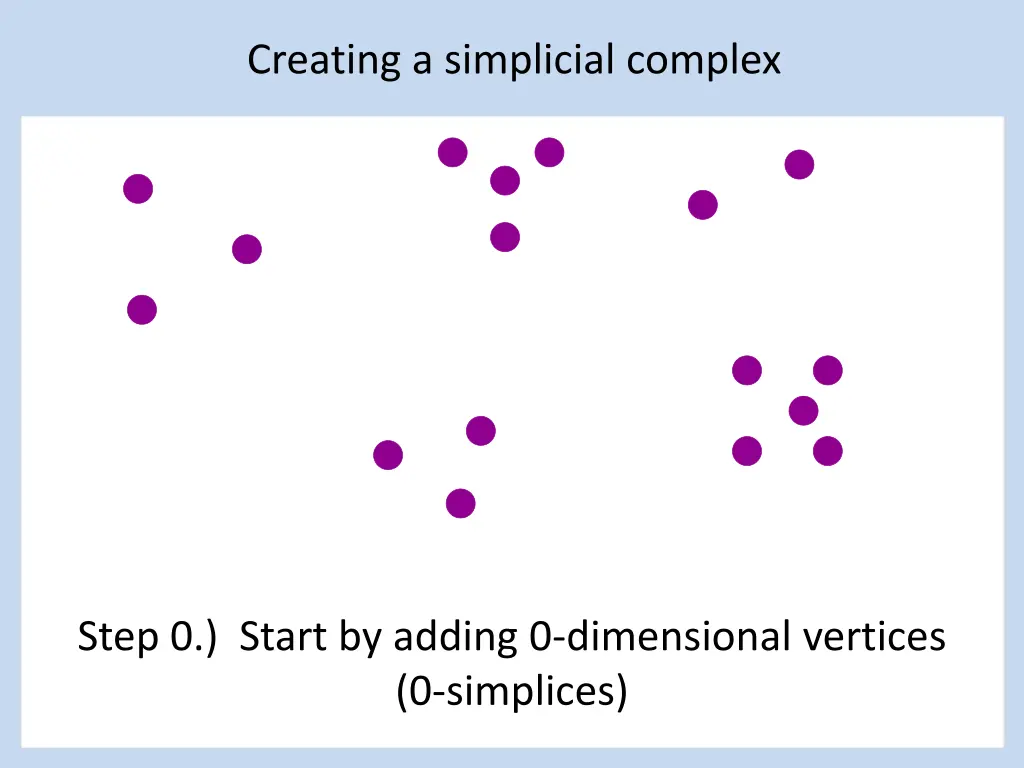
Creating Simplicial Complex: Step-by-Step Guide
Learn how to create a simplicial complex step by step, starting from adding 0-dimensional vertices to constructing Vietoris-Rips simplicial complex with detailed explanations and images. Understand the process of adding 1-dimensional edges, defining closeness between data points, and adding higher-dimensional simplices for topological analysis.
Download Presentation

Please find below an Image/Link to download the presentation.
The content on the website is provided AS IS for your information and personal use only. It may not be sold, licensed, or shared on other websites without obtaining consent from the author. If you encounter any issues during the download, it is possible that the publisher has removed the file from their server.
You are allowed to download the files provided on this website for personal or commercial use, subject to the condition that they are used lawfully. All files are the property of their respective owners.
The content on the website is provided AS IS for your information and personal use only. It may not be sold, licensed, or shared on other websites without obtaining consent from the author.
E N D
Presentation Transcript
Creating a simplicial complex Step 0.) Start by adding 0-dimensional vertices (0-simplices)
Creating a simplicial complex 1.) Adding 1-dimensional edges (1-simplices) Add an edge between data points that are close
Creating a simplicial complex 1.) Adding 1-dimensional edges (1-simplices) Let T = Threshold Connect vertices v and w with an edge iff the distance between v and w is less than T
Creating a simplicial complex 1.) Adding 1-dimensional edges (1-simplices) Let T = Threshold = Connect vertices v and w with an edge iff the distance between v and w is less than T
Creating a simplicial complex 1.) Adding 1-dimensional edges (1-simplices) Add an edge between data points that are close Note: we only need a definition of closeness between data points. The data points do not need to be actual points in Rn
Creating the Vietoris Rips simplicial complex 2.) Add all possible simplices of dimensional > 1.
Creating the Vietoris Rips simplicial complex 0.) Start by adding 0-dimensional data points Use balls to measure distance (Threshold = diameter). Two points are close if their corresponding balls intersect
Creating the Vietoris Rips simplicial complex 0.) Start by adding 0-dimensional data points Use balls of varying radii to determine persistence of clusters. H. Edelsbrunner, D. Letscher, and A. Zomorodian, Topological persistence and simplication, Discrete and Computational Geometry 28, 2002, 511-533.
Discriminative persistent homology of brain networks, 2011 Hyekyoung Lee Chung, M.K.; Hyejin Kang; Bung-Nyun Kim;Dong Soo Lee Constructing functional brain networks with 97 regions of interest (ROIs) extracted from FDG-PET data for 24 attention-deficit hyperactivity disorder (ADHD), 26 autism spectrum disorder (ASD) and 11 pediatric control (PedCon). Data = measurement fj taken at region j Graph: 97 vertices representing 97 regions of interest edge exists between two vertices i,j if correlation between fj and fj threshold How to choose the threshold? Don t, instead use persistent homology
Vertices = Regions of Interest Create Rips complex by growing epsilon balls (i.e. decreasing threshold) where distance between two vertices is given by where fi = measurement at location i
0-simplex = vertex = v 1-simplex = oriented edge = (vj, vk) vj Note that the boundary of this edge is vk vj vk e 2-simplex = oriented face = (vi, vj, vk) v2 Note that the boundary of this face is the cycle e1 + e2 + e3 e1 e2 v1 v3 e3
